Complete Guide to Women's Rights National Historical Park in upstate New York including things to do and see, history, nearby lodging, and more.

Women's Rights National Historical Park
About Women's Rights National Historical Park
From July 19-20th, 1848 a history-changing event took place in the village of Seneca Falls, New York.
300 people gathered for the first women's rights convention and signed a Declaration of Sentiments stating "that all men and women are created equal."
This declaration was a major step forward in women gaining voting rights, property rights, access to education, and workplace equality. The Women’s Rights National Historical Park celebrates this historic event.
Five local women from Seneca Falls started the arrangements for the convention. These women Elizabeth Cady Stanton, Lucretia Mort, Martha Wright, Mary Ann M'Clintock, and Jane Hunt are depicted in a sculpture at the national historical park.

Is Women's Rights NHP worth visiting?
YES!! This National Historical Park is amazing! It does a wonderful job of showing not only the 1st Women's Rights convention but also the fight for rights today.
History of Women's Rights National Historical Park
The Women’s Rights National Historical Park covers approximately six acres of land and is located in Seneca Falls, New York.
It consists of four points of interest: Wesleyan Methodist Church, The Elizabeth Cady Stanton House, the M’Clintock House, and the Richard Hunt House.
The formation of this historical spot was created to mark the occasion of the first Women’s Rights Convention or the Seneca Falls Convention.
One very influential woman is credited with beginning the movement that would eventually change the opportunities for all American women.
Elizabeth Cady Stanton was born in New York in 1815. Elizabeth received a superior education and worked in the law office of her father. It was there that she recognized many of the discriminatory laws that were aimed at women at that time.
In 1840, Elizabeth married lawyer and abolitionist Henry Brewster Stanton. That same year the couple attended the World Anti-Slavery Convention in London and Elizabeth was appalled at being barred from entering because she was a woman.
Back in the United States, by 1848, Elizabeth was a mother of three and still bothered by the outright denial of women’s rights in America, and the world, at the time.
Fellow friends and Quaker abolitionists agreed and were determined that immediate action must be taken. Supporters of the abolition of slavery were also supporters of women’s rights.
The organizers of this movement in New York were the families of the Motts, Wrights, Stanton's, M’Clintocks, and Hunts. Noted abolitionist and former slave Fredrick Douglass was a strong supporter of the movement as well.
The Convention was held at Seneca Falls, New York, as this was the home of Stanton. It was held on July 19th and 20th, 1948 at the Wesleyan Methodist Chapel. Nearly 300 people showed up to the convention, mainly area residents.
It was at this time that Stanton drafted her “Declaration of Sentiments” which was signed by 100 men and women.
It declared that “all men and women are created equal” and that all women should be allowed the right to vote, own property, serve on juries, and access equal educational opportunities.
For almost 50 years following, Stanton partnered with anti-slavery and women’s rights activist Susan B. Anthony.
The two women, passionate for change, complimented each other beautifully as Anthony was an exceptional organizer and Stanton was a brilliant speaker and writer.
The Visitor’s Center lobby at the historic site houses the bronze sculpture entitled “The First Wave.” This sculpture was commissioned after the historical site was established in 1993.
Artist Lloyd Lillie, a professor at Boston University, sculpted the life-size statues out of clay and used historical photographs to create true facial characteristics.
The sculpture depicts some of the women who were present at the convention in July of 1848, and also the men that were there to support them.
The sculpture includes the statues of twenty people: Mary Ann and Thomas M’Clintock, Lucretia and James Mott, Jane and Richard Hunt, Elizabeth Cady Stanton, Frederick Douglas, Martha Wright, and eleven unknown participants who represent men and women who attended but did not sign Stanton’s famed “Declaration of Sentiments.”
Although it took 72 years for this group’s dream of granting women the right to vote, this group was the “First Wave” of the fight for women’s rights which would continue for decades to come.
The Women’s Rights National Historical Park incorporates the relationship between the women’s rights movement and the anti-slavery movement. The M’Clintock House is located in nearby Waterloo, New York.
The M’Clintocks were signers at the Seneca Convention, and their home was also a stop on the Underground Railroad. The site offers education on the many connections between the two movements in the 19th century.
1950 Massachusetts was the site of the National Women’s Rights Convention in which many African Americans were in attendance. It was here that a strong connection was formed with the Abolitionist Movement.
During the Progressive Era of 1890 and 1925, women from all social classes and backgrounds began entering roles in public life. It was then that the term “Women’s Suffrage” became part of mainstream politics.
Between 1948 and the 1920s, many states showed their individual support for Women’s Suffrage. In 1918, President Wilson stated his support for the Women’s Suffrage Movement.
After World War I ended, Congress began the ratification process of the Nineteenth Amendment which states:
“The rights of citizens of the United States to vote shall not be denied or abridged by the United States or by any State on account of sex.”
On August 26, 1920, American women won full voting rights.
The Women’s Rights National Historical Park was established on December 28, 1980. Surely the houses and sites that were chosen for this park were instrumental in beginning the fight for women’s rights in America.
Elizabeth Cady Stanton’s home that she shared with her husband and family from 1847 to 1862 was called the “Center of Rebellion. It was here that many discussions and meetings took place when planning the movement.
The story of how the Seneca Convention came to be is brought to life at this historical park, and the significance of its role in changing life for American women is monumental.

Things to know before your visit to Women's Rights National Historical Park
Entrance fee
$0.00 - There is no fee to visit the park.
Learn more about National Park Passes for parks that have an entrance fee.
$80.00 - For the America the Beautiful/National Park Pass. The pass covers entrance fees to all US National Park Sites and over 2,000 Federal Recreation Fee Sites for an entire year and covers everyone in the car for per-vehicle sites and up to 4 adults for per-person sites.
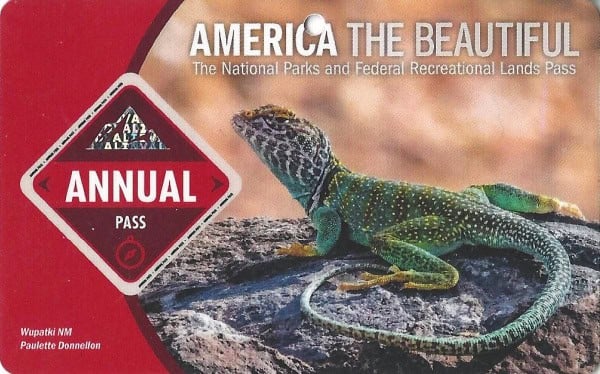
Buy your pass at this link, and REI will donate 10% of pass proceeds to the National Forest Foundation, National Park Foundation, and the U.S. Endowment for Forestry & Communities.
National Park Free Entrance Days -Mark your calendars with the five free entrance days the National Park Service offers annually.
Time Zone
Eastern Time Zone
Pets
Pets are allowed in the outdoor areas of the park while on a leash.
Cell Service
We had great cell service while visiting the park.
Park Hours
Open Daily from 9:00 am to 5:00 pm, Closed on New Year's Day, Thanksgiving Day, and Christmas Day.
Wi-Fi
Wi-Fi is available at the visitor center.
Insect Repellent
Insect repellent is always a great idea when outdoors, especially if you are around any body of water.
We use Permethrin Spray on our clothes before our park trips.
Water Bottle
Make sure to bring your own water bottle and plenty of water with you. Plastic water bottles are not sold in the park.
Parking
There is street parking and nearby parking lots by the park.
Food/Restaurants
There are no restaurants within the park.
Gas
There are no gas stations within the park
Drones
Drones are not permitted within National Park Sites.
National Park Passport Stamps
National Park Passport stamps can be found in the visitor center.
Women's Rights NHP is the National Stamp for the 2020 Passport Stamp Set.
We like to use these circle stickers for park stamps so we don't have to bring our passport book with us on every trip.
The National Park Passport Book program is a great way to document all of the parks you have visitied.
You can get Passport Stickers and Annual Stamp Sets to help enhance your Passport Book.
Electric Vehicle Charging
There are 32 public EV Charging Stations within Seneca Falls, New York.

Details about Women's Rights National Historical Park
Size - 5 acres
Check out how this National Historical Park compares to other National Parks by Size.
Date Established
Women's Rights National Historical Park was created by Congress in 1980.
Visitation
In 2021, Women's Rights NHP had 22,847 park visitors.
In 2020, Women's Rights NHP had 8,237 park visitors.
In 2019, Women's Rights NHP had 39,064 park visitors.
Learn more about the most visited and least visited National Parks in the US
National Park Address
136 Fall Street
Seneca Falls, NY 13148
Park Phone Number - (315) 568-0024
National Park Map
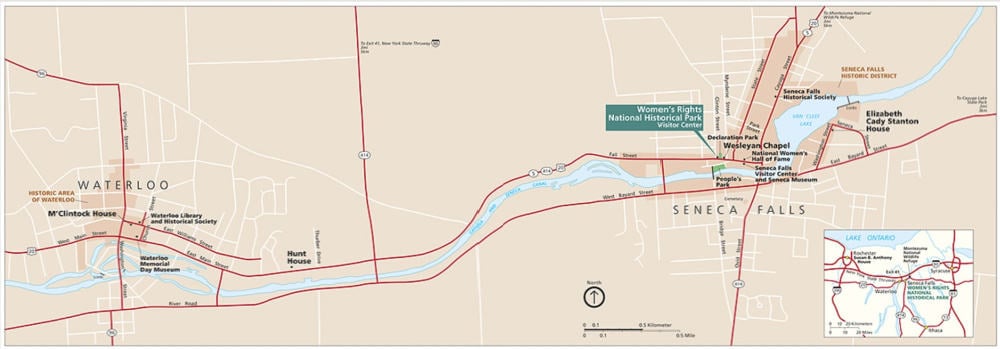


Where is Women's Rights National Historical Park?
Women's Rights NHP is located in Seneca Falls in northern New York near the Finger Lakes including Seneca Lake, Cayuga Lake, and Owasco Lake.
Estimated distance from major cities nearby
- Ithaca, NY - 41 miles (Check out top things to do in Ithaca)
- Rochester, NY - 52 miles
- Buffalo, NY - 118 miles
- Niagara Falls, NY - 127 miles
- New York, NY - 266 miles
- Philadelphia, PA - 273 miles
- Boston, MA - 353 miles
Estimated Distance from nearby National Park
Acadia National Park - 624 miles
Cuyahoga Valley National Park - 309 miles
Indiana Dunes National Park - 599 miles
New River Gorge National Park - 555 miles
Great Smoky Mountains National Park - 751 miles
Where is the National Park Visitor Center?
The Visitor Center is at 136 Fall Street, Seneca Falls, NY 13148.

Getting to Women's Rights National Historical Park
Closest Airports
- Ithaca Tompkins Regional Airport (ITH)
International Airports
- Syracuse Hancock International Airport (SYR)
- Greater Rochester International Airport (ROC)
- Buffalo Niagara International Airport (BUF)
Driving Directions
From the New York State Thruway (I-90) take exit 41 (Route 414).
Turn right onto Route 414 South after exiting the tollbooth. Follow Route 414 South for approximately four miles.
At the intersections of Route 414 and Routes 5 & 20, turn left onto Route 5 & 20 East.
Follow for approximately one and a half miles into the Village of Seneca Falls.

Best time to visit Women's Rights National Historical Park
The best time to visit the park is really anytime other than winter unless you like snow.
Weather and Seasons
Seneca Falls, New York has warm summers and snowy cold winters.
The hottest temperatures are from May 26th to September 17th with an average daily temperature above 73 degrees.
The coldest temperatures are from December 2nd to March 13th with an average daily temperature below 42 degrees.
The rainiest month is September with an average of 3.1 inches.
Snow occurs from November 10th to April 11th on average. The snowiest month is February.

Best Things to do in Women's Rights National Historical Park
We suggest planning at minimum a half a day to visit the park. Between the visitor center and visiting each of the sites, you will want a few hours.
Visitor Center
Make sure and plan time to explore the visitor center at the Women's Rights National Historical Park. The interpretive displays are truly amazing. They make you think while also doing a great job of explaining women's rights in history and today.
Watch the park film: Dreams of Equality (25 minutes) showtimes: 9:15 am, 10:00 am, 11:00 am, 12:00 pm, 1:00 pm, 2:00 pm, 3:00 pm and 4:00 pm
Junior Ranger Program
The Women's Rights NHP Junior Ranger program can be completed within the visitor center. It guides you to really understand the importance of the park.
Wesleyan Chapel
Visit the location of the First Women’s Rights Convention in America held on July 19th and 20th in 1848!
300 people gathered in the chapel to attend the convention.
136 Fall Street, Seneca Falls, NY
Open Daily from 9:00 am to 4:30 pm (Closed Thanksgiving Day, Christmas Day, and New Year’s Day)
Waterfall at Declaration Park
The waterfall at Declaration Park is a 100-foot-long bluestone water feature. The waterfall is inscribed with the words of the Declaration of Sentiments.
Declaration Park is located next to Wesleyan Chapel.
136 Fall Street, Seneca Falls, NY
Open Daily, Dawn to Dusk
Elizabeth Cady Stanton House
The home of Elizabeth Cady Stanton is a few minutes from the visitor center.
She was the main organizer of the Seneca Falls Woman's Rights Convention and the primary author of the Declaration of Sentiments.
Ranger-led tours are offered so visitors can see the inside of the house.
32 Washington Street, Seneca Falls, NY
Open Seasonally (Memorial Day Weekend to Columbus Day Weekend)
Friday, Saturday, and Sunday from 12:00 pm to 4:00 pm
M'Clintocks House
The First Women's Rights Convention and the Declaration of Sentiments were drafted in the home of Thomas and Mary Ann M'Clintock.
14 Williams Street, Waterloo, NY
Open Seasonally (Memorial Day Weekend to Columbus Day Weekend)
Friday, Saturday, and Sunday from 10:00 am to 2:00 pm

Ranger Guided Walking Tour
The walking tours leave from the Visitor Center and travel through the Historic District to the Elizabeth Cady Stanton House. The tours take an hour on average and you will walk two miles during this time.
Hunt House
This house is not yet open to the public.
401 East Main Street, Waterloo NY
Convention Days
The park is hosting Convention Days 2022: Abolitionist Roots of the Women's Rights Movement in July.
This annual event provides visitors the opportunity to engage in Women's history, learn more about the 1848 Seneca Falls Women's Rights Convention through speakers, art, and more.

How to beat the crowds in Women's Rights National Historical Park?
We did not experience any crowds while visiting the park. We do suggest visiting mid-week if you want to skip the busiest times at most parks.
Where to stay when visiting Women's Rights National Historical Park
There are no National Park Lodges within the park.
There are lodging and vacation rentals available in Seneca Falls and the surrounding Finger Lakes area.
The Gould Hotel is located just down the street from the park.
Hampton Inn Seneca Falls - Consider a stay at Hampton Inn Seneca Falls and take advantage of free to-go breakfast, dry cleaning/laundry services, and a 24-hour gym. Stay connected with free WiFi in public areas, and guests can find other amenities such as a business center and a snack bar/deli.
Fairfield Inn & Suites by Marriott Geneva Finger Lakes - Take advantage of dry cleaning/laundry services, a gym, and a 24-hour business center at Fairfield Inn & Suites by Marriott Geneva Finger Lakes. Guests can connect to free in-room WiFi.
Geneva On The Lake - 3-star hotel by the lake. At Geneva On The Lake, you can look forward to a roundtrip airport shuttle, a terrace, and a garden. Active travelers can enjoy rowing/canoeing, sailing, and fishing at this hotel. Treat yourself to a massage or other spa services. The onsite fine-dining restaurant, Lancellotti's, features garden views. Enjoy the gym, as well as activities like boat tours, volleyball, and kayaking. Free in-room WiFi is available to all guests, along with dry cleaning/laundry services and a bar
Click on the map to see current rates for other hotels and vacation rentals in the area.
Camping
There are National Park Campground within the park.

For a fun adventure check out Escape Campervans. These campervans have built in beds, kitchen area with refrigerators, and more. You can have them fully set up with kitchen supplies, bedding, and other fun extras. They are painted with epic designs you can't miss!
Escape Campervans has offices in Vancouver, Seattle, Portland, San Francisco, Las Vegas, Los Angeles, Phoenix, Salt Lake City, Denver, New York, and Orlando
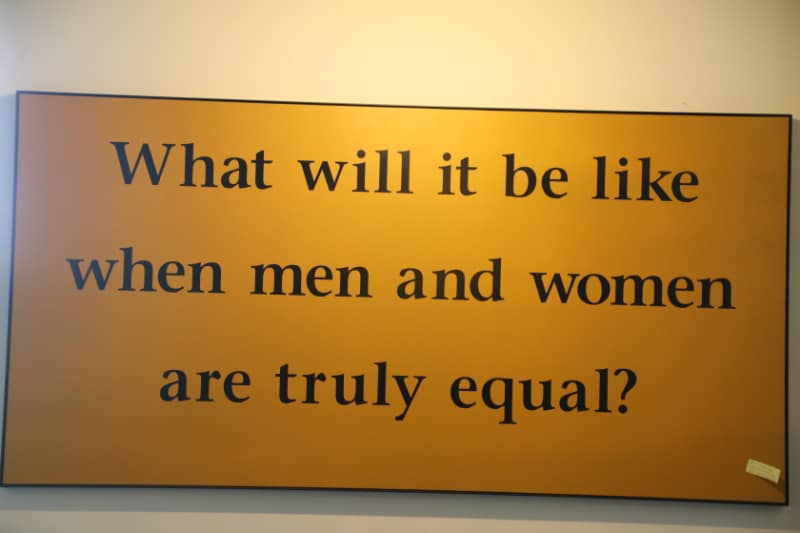
Additional Resources
What Is the Women's Rights Movement? (What Was?)
The Agitators: Three Friends Who Fought for Abolition and Women's Rights
Extraordinary Women In History: 70 Remarkable Women Who Made a Difference, Inspired & Broke Barriers
Parks Near Women's Rights National Historical Park
Harriet Tubman National Historical Park - 16.5 miles
Fort Stanwix National Monument - 85 miles
Saratoga National Historical Park - 186 miles
Theodore Roosevelt Inaugural National Historic Site - 114 miles
Marsh - Billings - Rockefeller National Historical Park (Vermont) - 284 miles
Saint-Gaudens National Historic Site (New Hampshire) - 296 miles
Check out all of the National Parks in New York along with neighboring National Parks in Connecticutt, National Parks in Massachusetts, National Parks in New Jersey, National Parks in Pennsylvania, Rhode Island National Parks, and Vermont National Parks
Check out all of the National Historical Parks managed by the NPS
Make sure to follow Park Ranger John on Facebook, Instagram, Pinterest, and TikTok

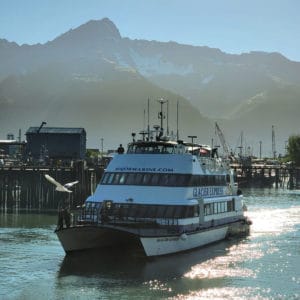

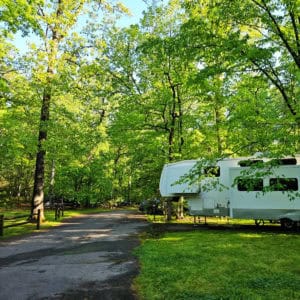

Leave a Reply